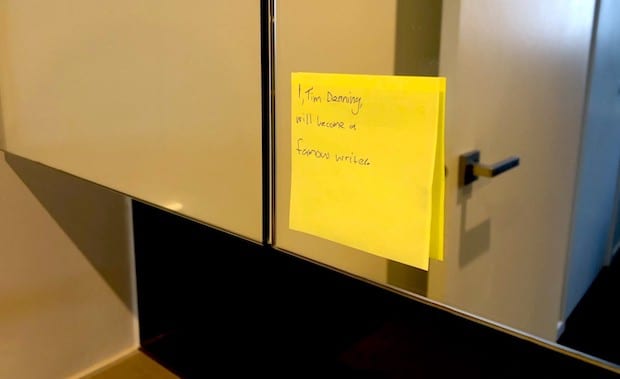Startups
8 Tips Game Developers Can Teach Startups About Crowdfunding

You are about to learn the power of game developers and the principles they live by which can cause any startup to thrive if followed correctly. Never have I met two guys who are more passionate about what they do than Trent Kusters and Blake Mizzi who are two of four directors from game development collective League Of Geeks (LoG for short). To date, LoG have spent about $800k AUD on creating their game Armello and have crowdfunded nearly half of that through Kickstarter.
In Trent and Blake’s mind LoG is a collective of artists trying to create experiences, build amazing games and wow their users, but what I don’t think they realise is that their business plan, techniques and execution is probably better than most Fortune 500 companies. They have taken gaming concepts and applied them to their business with overwhelming success. When you couple that with a supportive government in Victoria (Australia) who understand how important the gaming industry is to the local economy, you have a Master Chef recipe for success. (GET EXCITED!!!)
***The Secret Sauce of Armello***
League Of Geeks is a game development collective that is structured so that they can work and collaborate with developers all around the world. They have created a world first model that works by gamifying the development of their game.
One of the directors had worked for a large game studio before joining League Of Geeks, and after he had left a company that he helped create into a world-class brand, he was left with nothing. This studio had tried their own version of a profit-share model, but it left the hourly rate of developers at something that was less than the industry average. After a failed attempt at starting a studio with a profit share model and the experience of leaving a big studio with nothing, the guys thought there had to be a better way to remunerate their team members.
Instead of using a numerical share the guys pivoted their new studio to have a gamified points based system. The points are earned based on a successfully, completed and approved task within their project. As all the tasks are being completed, they are accumulating into a pool of finished points. The total profits of the game are then sliced up between the company (League Of Geeks) and all the contributors.
The more tasks you do, the more points you earn and the more your percentage is of the games profits. The most important part when coming up with this point system is to understand how many hours your project will take, how many points will be needed and what the projected profits are of the project.
When you know this you can mathematically work out if the hourly rate is fair for the work your contributors need to do. It is unfair if someone spends fifty hours doing work for you and gets $5. The system must be honest, and a contributor should be able to earn more money from points than being paid hourly by the company.
To manage all of this the guys use the Pivotal Tracker software that helps them to see the velocity of their project and at what date certain milestones of the game will be completed – they can even see real time distractions like this interview affect their output. How can you implement the world-class technology that League Of Geeks has come up within your startup?
Below are Trent and Blake’s top eight tips to creating a textbook crowdfunding campaign for your startup.
1. Talk with other highly successful crowdfunding campaigns
Before the Armello guys did their campaign, they spoke with the top Video Game success stories from Kickstarter to see what they did to be successful at raising lots of money. It’s a great idea to hit them with questions and find out from them what worked, what didn’t work and what they would do again. You could even take it one level above that and send them a copy of your draft crowdfunding campaign and ask them for feedback.
The guys spent months researching Kickstarter and they describe it as a bit of a dark art where you hear legends that something might work if you say it in a certain tone or if the moon hits a certain position then a different strategy could work. Even though you can talk with other successful campaign founders, and their campaign could do everything right, just remember that their success is for that point in time – another point in time might yield completely different results even if you mirror the campaign with your own story. Some of the techniques though are timeless and can work at any point in time.
One lesson that the guys learnt from speaking with these other video game developers was that they had backers that had paid for the $10k tier, but in the end they just couldn’t afford it. If you can’t make your goal without having big tiers, then you’re in trouble anyway. Not all, your pledges will come through, and you have to expect a 15% drop off when you come to collect your pledges. The most common pledges that fall off are the larger ones. You can also get some users doing crazy pledge amounts just to troll your project.
Other backers from successful campaigns received a reward to come and spend a day at the game developers studio and the whole experience was an awkward interaction where it didn’t feel like there was a fair exchange of value. In these situations, you can feel like your time is not worth $10k and that that person could have just called up, and you would have let them come down and check out the studio for free. The Armello guys learnt from this advice, and from a responsibility point of view, they decided not to have monster high pledge tiers.
Kickstarter has 200-300 categories, and there is no precedence for this type of economic model ever before crowdfunding arose. Every single one of those categories has different purchaser and backer behaviours, so it’s worth studying your campaign’s niche thoroughly.
2. Communicate your why correctly
Kickstarter provides what’s known as good money, which means that there is no real legal obligation and no interest on the money to be paid. A lot of the campaign owners and backers work on a trust system and are trying to fill a need, so it’s very important to communicate your why correctly. You have to have a good product and not just one that anybody can get anywhere. It’s always good to come to Kickstarter when you really need the money because this will come through in your pledge, and it did for the Armello game.
Putting up a campaign where you say, “we have made the product already but we thought we would raise money anyway,” won’t work. In this scenario, there is no reason for someone to jump on board. A crowd of people will usually jump onboard your campaign because of compassion for your cause or early access to your product. Early access is appealing when you make the person feel like they are guiding the development and helping the developer finish the final product not just early access to something.
“People want to feel like they are the savior and that your boat is filling with water and they have jumped on with buckets to stop you sinking”
3. Create a rally and cry
When your startup is told by the industry that there isn’t a market for what you’re doing, your campaign can help create a call to arms that there is a need and for people to show their interest. Campaigns that demonstrate that the only way for something to be done is via crowdfunding, seem to work best. A great example is a game called Star Citizen where the gaming publishers of the world thought PC Games were dead and these guys proved through their campaign that they’re not.
Your campaign needs to be something that can only be achieved through crowdfunding and is the last hope to get the project off the ground.
Sell the dream of crowdfunding that people can come on board and make the game or project better. Give the users a sense that they will get one hundred times the value in return for their $15 pledge. When creating this rally make sure the page flows in the best possible way it can. For example, if you have beautiful music that accompanies your project you could tell the user to click play on the music as they are reading your story. Once your final story is up on the site consider cutting out sections that you don’t need and editing each section down to half of its length – only keep the critical content.
4. Implement a multi-stage campaign that is well timed
You shouldn’t bring your product to crowdfunding until you have a demo, and in the case of a game, something that can be played in some way, otherwise you are raising money too early. Part of LoG’s success with crowdfunding was to implement a three-stage campaign. They, first of all, ran their 30-day Kickstarter campaign that made them $305k. They then followed this up with a two and a half month Slacker Backer campaign that allowed them to keep collecting pledges on their website after the campaign was over.
The final step was to follow all of this up with an automated Backer Kit service one month after the Slacker Backer campaign. Backer Kit has been specifically designed to import all your data from other campaigns and merge it with your Kickstarter campaign.
On a platform like Kickstarter, you don’t have access to your backers contact details or their location. Backer Kit brings in a lot more details about your backers although the users must volunteer that information to you. This databasing of your backers allows you to generate CSV files and reports in case you want to email them or find out the geography of the backers (great for working out your tax bill).
Once Backer Kit has all your data in one place, it then sends out a customer service / survey email to your backers to manage the after campaign experience. The primary function it does though is to allow backers to increase their pledge tier from the one they originally selected, say $35, up a level to something like the $55 tier. Backers can also add add-ons, update their shipping address and details, which allows you to not have to deal with the customer service end of your campaign and tie everything in together.
5. Video – lights, camera, action
A high number of people that go to your page will watch the video, so this is crucial. Only a small number of projects that don’t have a video actually get funded. For the video to resonate it’s a good idea to have you or one of the other founders talking to the backers and to get your team on camera as well. A good closing line to your video could be “we want to bring this product to life, and we need you to make this happen!”
Your video should sell the dream, have a call to arms, be short and succinct, no longer than 3 minutes and ideally have some juicy animation if you can. Videos that are longer than 5 minutes typically have a rough drop off rate of 90% so make sure you follow the 3-5 minute format.
Watch Trent show you how a good video should be presented
6. Try some of these promotion techniques
The first four days of your campaign are the most important and you shouldn’t intend on sleeping at all, only promoting your campaign like crazy in every possible way you can. 40% of your funds will be raised during this time so if you only get 10% of your total pledge, then your campaign is usually over. What you raise in the first four days of your campaign is what you will do in the last four days. Thirty-five days is the best length for a campaign so try and set this as the length if you want to be successful.
A technique that can work well on Kickstarter is to cross-promote other campaigns in your updates. This cross-pollination is well received and will see some mutually beneficial promotion occur early on – campaigns speak to each other. Outside of the Kickstarter platform the next biggest attributer to funds for Armello was Twitter and then Facebook. The Armello guys saw that as soon as they put out a tweet or a post, they would see an injection of cash into their Kickstarter campaign – you have to be there stroking those oars on the rowboat.
Thirty Days of Despair
A crowdfunding campaign typically has a spike of funds in the beginning, a spike at the end and a trench in the middle where no matter what you do you can’t seem to raise a lot of funds.
To prove that crowdfunding is a bit of a dark art, Blake and Trent said that during one part of the Armello campaign the guys got IGN (one of the largest gaming sites in the world) to tweet a gameplay reveal to millions of people on their Youtube and Twitter accounts, and they didn’t see a single bump to pledges at all. Three days later a smaller site called Kotaku posted another gameplay video, and this then caught the tail end of their campaign that helped them raise $150k. You never know which marketing campaign is going to deliver.
The engagement with your campaign is really important as to whether your marketing will work, and people will pledge. The projects that typically get funded have a high amount of comments, so it’s important for you to stimulate the conversation on your crowdfunding page and get people talking. The more comments you have, the better your curation will be within Kickstarter’s platform.
During Armello’s 30-day Kickstarter campaign, the guys were on shifts managing their page 24/7 and replying to people’s questions. If a user reaches out and then you reply back straight away and then someone else sees you answering questions then they will ask a question. To create this natural viral loop, you must be 100% committed during the whole campaign to be there no matter what. The Armello page even had some of the users calling themselves the champion of the game so Trent and Blake would answer their questions and address them as the champion to make them feel inclusive of a community.
Most of your pledges will be International – UK and USA are typically the highest. This means that you shouldn’t concentrate your marketing in one country and try and target a few of the places where you see pledges coming from. Three days after the start of the Armello Kickstarter campaign, Trent jumped on a plane to the USA to start promoting what they were doing at a convention – don’t be afraid to do the media circuit in person in conjunction with your online marketing.
The Bitly secret weapon
When you’re posting links to your crowdfunding campaign on social media you should always try and use something like a custom Bitly links so that you don’t have some giant URL that won’t fit in a tweet. These links are typically more memorable, easier for people to share and will give you greater analytics as to who’s clicking the link.
7. Structure your rewards strategy
You must have clear, well-defined goals that are easy to read and understand aren’t convoluted, and that offer people real value every time they step up. To achieve this, you will need to have a focused strategy with your rewards. For the Armello game, the main goal was to funnel everyone into the $55 tier and then if they got a chance, they would encourage backers to go to a higher rewards tier from there.
One of the secrets is not to necessarily have lots of backers, but to have a high amount of money raised at the end. Due to the strategy with Armello’s rewards, the game raised more than $300k with a very low number of backers, because the average pledge was $49, which is quite high for a crowdfunding campaign.
The Armello guys were able to get people up to the next tier because as soon as a backer purchased the game at the base tier, immediately they created something new that came out which communicated that it was better value to go up another tier. Then a backer moves up again because something new has been added into another one of the higher tiers, etc.
Against each tier, you should profile a buyer type. For example, on one tier the Armello guys based the tier around someone who would love the audio, on another it was a buyer that might like the story books, or someone that wants to be the collector, or someone that wants to be the hardcore gamer to get in early. Different buyer types could then correspond to different pledge amounts, which you need to estimate to work out how much someone might pay. People that like the physicality of collector items might be willing to pay more than someone that just likes the audio of the game.
When offering physical rewards like figurines, books or t-shirts it can be very easy to get a quote from a manufacturer, set the pledge amount and then find that when you come to fulfil that order the price to manufacture and ship can be a lot more expensive. The way to overcome this is to build in a large buffer in case the cost of your rewards are more than expected.
8. Community is everything with crowdfunding
Kickstarter allows you to build a community, and the core community are coming onboard for the ride. The platform allows you to make your biggest fans even bigger fans, and you’re making them champions to go out and promote your product.
You’re also making your product better because this community is then getting early access to try it out and help shape the direction of the product build better. The community helps to make you more accountable because when you hear the bad feedback you instantly want to fix the issues they are facing.
The majority of your funding from Kickstarter will come from people browsing Kickstarter. These people that browse Kickstarter are almost like nomadic tribes that go from project to project. When a backer puts in $15, they get to go on a roller coaster ride, and it can be quite addictive because of this.
Trent and Blake’s favourite books are:
1. Good Strategy, Bad Strategy – Richard Rumelt
2. Too Soon Old, Too Late Smart – Gordon Livingston
If you would like to play the League Of Geeks very popular Armello game, it is now available on STEAM early access here.
It’s also worth mentioning that the Armello games success wouldn’t have been possible without the support from The Arcade Melbourne (game developer co-working space), The Game Developers Association of Australia, Film Victoria, Screen Australia and Creative Victoria.
Shift Your Mindset
10 Powerful Traits Every True Thought Leader Possesses
In a world saturated with noise, thought leadership is the quiet power that shifts paradigms.

Thought leadership is more than just having strong opinions. It’s the ability to influence, inspire, and guide others by sharing original insights, innovative ideas, and deep domain expertise. It’s about sparking change, not just talking about it. (more…)
Startups
The Young Man’s Guide to Creativity: 10 Daily Habits to Improve Your Creative Mind
10 daily habits you can put into practice right now to improve your creativity

When I was 22 years old, I became a Top Writer on Medium.
It’s not an easy path. I lived in the Philippines and had never received a penny after writing over 100 digital articles. But I treated it like practice. If I couldn’t get other people to read my work for free, why would they trust me? (more…)
Startups
If You’re Not Reinventing Yourself, You’re Falling Behind! Here’s What To Do
Reinvention is the secret weapon of high performers.

Reinvention is the secret weapon of high performers.
Most careers follow a predictable script. You start at the bottom, climb the ranks, and eventually settle into something resembling stability. But the people who make the biggest impact, the ones who don’t just play the game but change it, break that script. They evolve. They shift. They reinvent. (more…)
Startups
The Silent Killer of Startups: This Might Be Draining Your Profits
If you are careless in managing your inventory, it can lead to a sudden depletion in cash flow

There are several issues in a startup, but if you are really careless in managing your inventory, it can lead to a sudden depletion in cash flow. Old, broken, and misplaced stock wastes space and profits. If inventories and storage aren’t managed properly, it hardly ever works.
-

 Success Advice4 weeks ago
Success Advice4 weeks ago11 Mark Manson Lessons That’ll Redefine Success in the Digital Age
-

 Business4 weeks ago
Business4 weeks agoThinking of Buying A Business? These 6 Sectors Quietly Produce the Best Deals
-

 Change Your Mindset3 weeks ago
Change Your Mindset3 weeks agoWork-Life Balance Isn’t a Myth: Here’s How to Actually Make It Happen
-

 Change Your Mindset3 weeks ago
Change Your Mindset3 weeks agoThe Four Types of Happiness: Which One Are You Living In?
-

 Life2 weeks ago
Life2 weeks ago9 Harsh Truths Every Young Man Must Face to Succeed in the Modern World
-

 Success Advice2 weeks ago
Success Advice2 weeks agoInside the TikTok Resume Hack That’s Fooling Recruiters (For Now)
-

 Change Your Mindset1 week ago
Change Your Mindset1 week agoThe One Leadership Habit That Separates the Great From the Forgettable
-

 Personal Development4 days ago
Personal Development4 days agoThis Silent Habit Might Be Sabotaging Your Career




















2 Comments